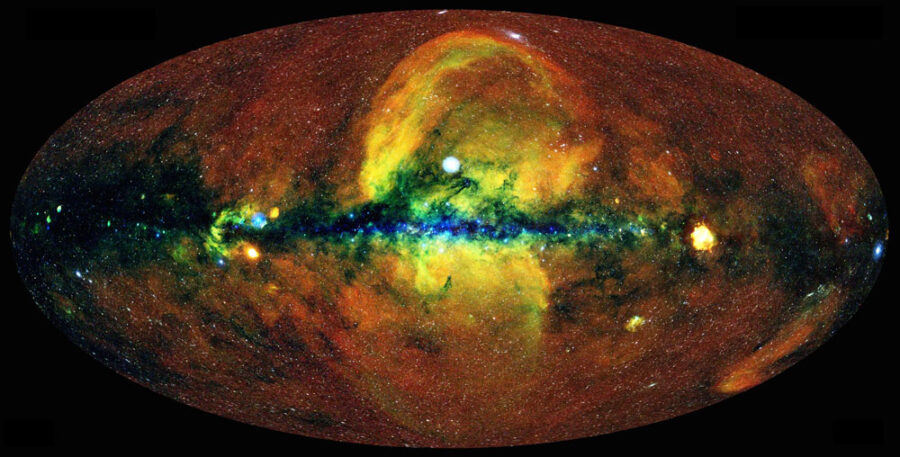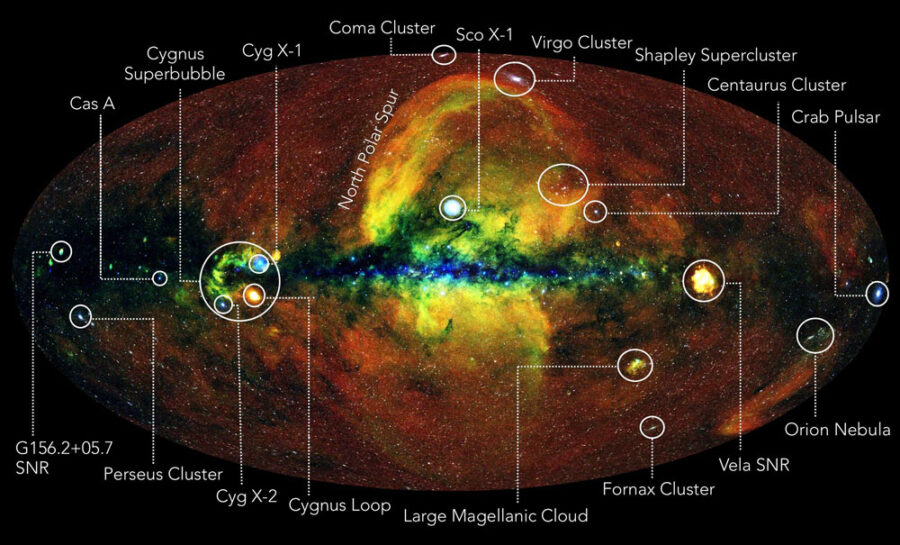The first all-sky X-ray map to be released in 30 years reveals new wonders of the hot and energetic universe.

J. Sanders, H. Brunner & eSASS team (MPE) / E. Churazov, M. Gilfanov (on behalf of IKI)
The eRosita space telescope, which launched in July 2019, has completed its first full sweep across the sky, mapping both hemispheres and cataloging more than 1 million X-ray sources. This is only the first all-sky map to be delivered: The mission plans to create seven more maps, combining them to achieve unprecedented sensitivity to the whole X-ray sky.
One of the key science goals of this mission is to find new galaxy clusters, more distant than ones discovered before, and use them to track the growth of cosmic structure over time. But the multiple maps enable the mission to study other sources, too, including ephemeral ones like flares of light coming from around black holes.
X-ray Vision
The eRosita telescope flies on the Spektrum-Röntgen-Gamma spacecraft, a joint German-Russian mission that operates at the L2 Lagrange point, 1.5 million kilometers (900,000 miles) away on the opposite side of Earth from the Sun. As the telescope rotates, it scans the X-ray sky with seven cameras, taking exposures of 150 to 200 seconds over most of the sky. (The poles have longer exposure times.) The images record photon energies between 300 and 5,000 electron volts.
In half a year, the mission has already doubled the number of known sources collected since the start of X-ray astronomy in the 1960s. Some of these sources are pointed out below:

J. Sanders, H. Brunner & eSASS team (MPE) / E. Churazov, M. Gilfanov (on behalf of IKI)
This sky is decidedly different from the one we see at night. Only the hottest gases and the most extreme and active sources emit X-rays. While the mission sees some stars, whose magnetic activity creates X-ray-emitting flares, most of the sources are active galactic nuclei, in which hot gases swirl into the maw of supermassive black holes. Other X-ray sources include the hot gases released in supernovae explosions and the far more tenuous gas in and around our galaxy.
The active galaxies that pepper the sky — and account for more than three-quarters of the tally — outnumber eRosita’s true quarry: galaxy clusters. The hot gas spread out in the vast space between galaxies emits X-rays. So by looking for these X-ray blobs, the telescope can find galaxy clusters back to when the universe was only half its current age. Galaxy clusters mark junctures in the cosmic web, so by plotting a large number of clusters over billions of years, astronomers can watch large-scale structures evolve. With more than 20,000 clusters spotted so far, the mission is on track to find more than 100,000 when its surveys are complete.
The researchers continue to analyze the first results even as the mission begins its second round of sky-mapping. The eRosita mission will start making its data public around the summer of 2022, says eRosita principal investigator Peter Predehl (Max Planck Institute for Extraterrestrial Physics, Germany).
Zoom In
Explore regions of eRosita's all-sky map using the Worldwide Telescope.
Vela Supernova Remnant
(Hint: Use the toolbox controls at the upper right to change the background to ROSAT/RASS, then use the cross-fader to see how much eRosita has improved upon the previous all-sky X-ray survey, released 20 years ago.)
The Large Magellanic Cloud
Explore other Worldwide Telescope views here:
✦ Shapley Supercluster
✦ Carina Nebula
 0
0









Comments
You must be logged in to post a comment.